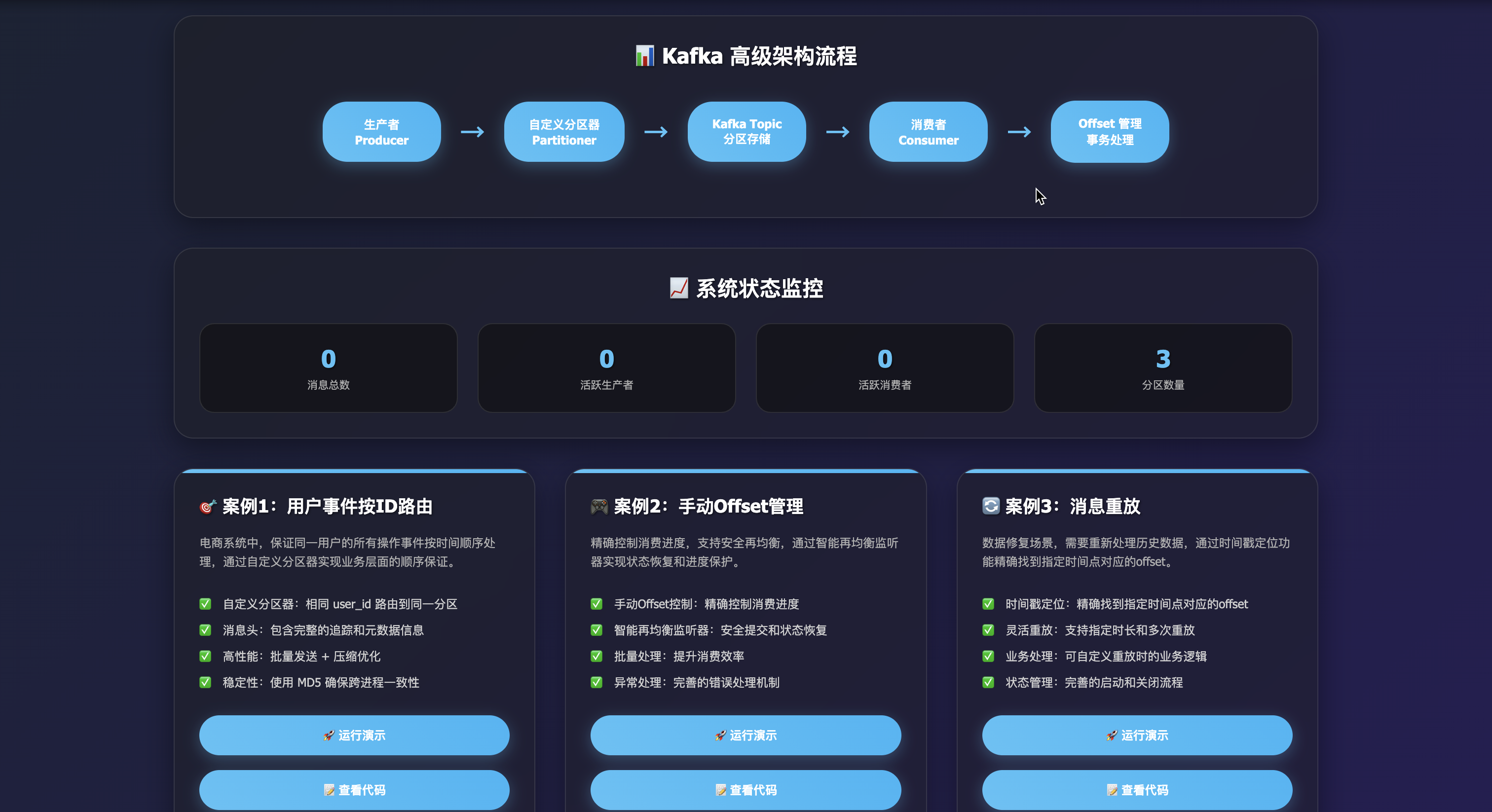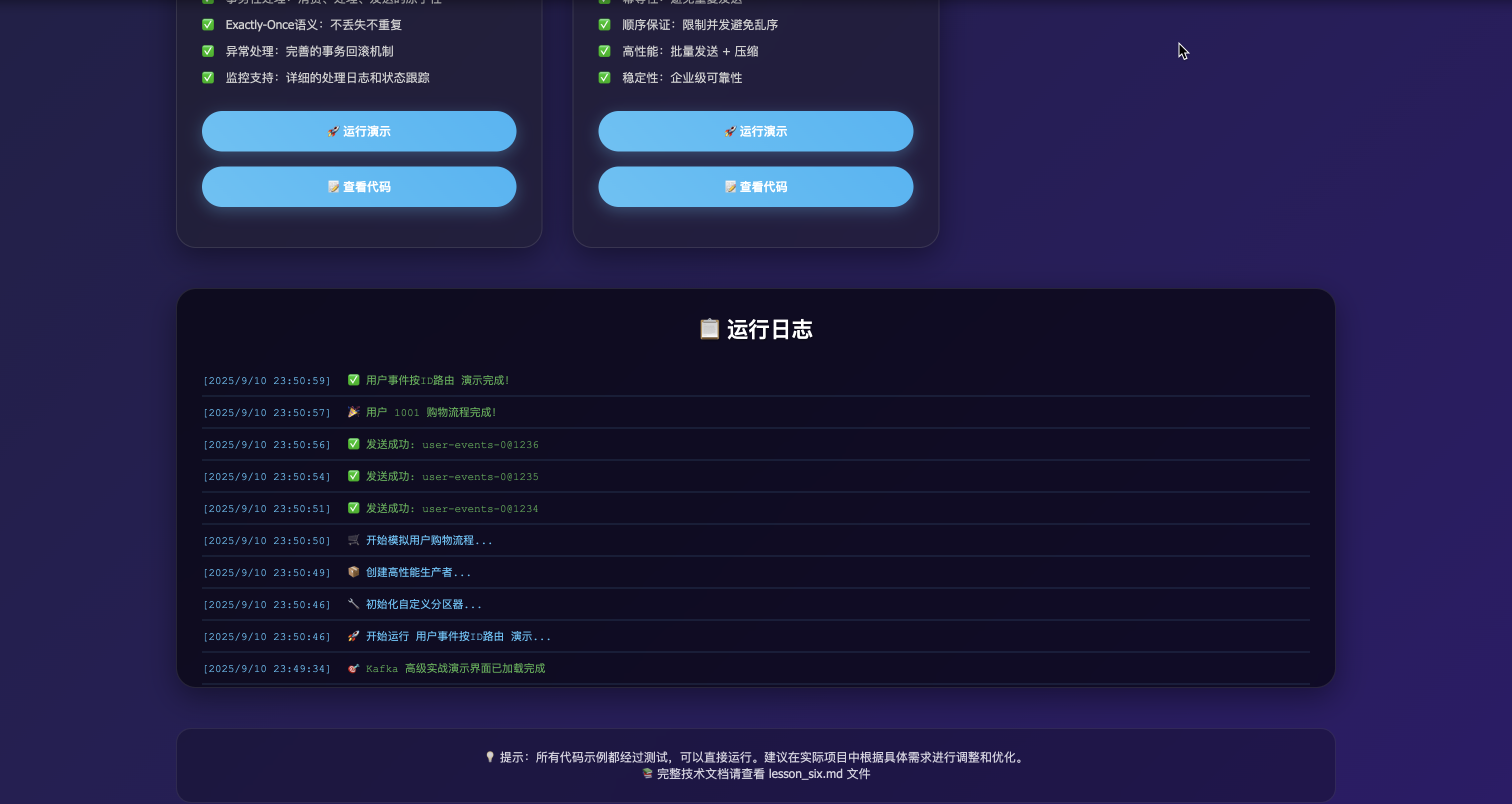Kafka 高級實戰:生產者路由與消費者管理(Python 版)
從基礎到進階:深入理解 Kafka 的生產者消息路由、消費者 Offset 管理,以及 Exactly-Once 語義實現
實戰導向:提供完整的可運行代碼示例,涵蓋自定義分區器、消息頭、大消息處理、Offset 控制、事務性消費等核心場景
🚀 快速開始
環境準備
# 基礎客戶端(純 Python,適合大多數場景)
pip install kafka-python==2.0.2# 高級客戶端(依賴 librdkafka,支持事務和更高性能)
pip install confluent-kafka==2.6.0# 可選:壓縮算法支持
pip install lz4 snappy zstandard
前置條件
確保 Kafka 集群已啟動:
# 使用 Docker 快速啟動 Kafka
docker run -d --name kafka \-p 9092:9092 \-e KAFKA_ZOOKEEPER_CONNECT=localhost:2181 \-e KAFKA_ADVERTISED_LISTENERS=PLAINTEXT://localhost:9092 \confluentinc/cp-kafka:latest
📚 核心概念深度解析
1. 生產者核心原理
🎯 分區與消息順序
Kafka 的核心設計原則:只保證同一分區內的消息順序。這意味著:
- ? 同一分區內:消息嚴格按發送順序存儲和消費
- ? 跨分區:無法保證全局順序
- 🎯 業務順序:通過相同 key 路由到同一分區實現業務層面的順序保證
🔧 自定義分區器設計
關鍵挑戰:Python 內置 hash() 函數使用隨機種子,重啟后結果不一致!
# ? 錯誤做法:Python hash() 不穩定
def bad_partitioner(key_bytes, all_partitions, available_partitions):return all_partitions[hash(key_bytes) % len(all_partitions)]# ? 正確做法:使用穩定哈希算法
import hashlib
def stable_partitioner(key_bytes, all_partitions, available_partitions):if key_bytes is None:return available_partitions[0] # 無 key 時的策略h = int(hashlib.md5(key_bytes).hexdigest(), 16)return all_partitions[h % len(all_partitions)]
📦 消息頭(Headers)的威力
Headers 是消息的元數據載體,典型應用場景:
- 鏈路追蹤:
trace_id、span_id - 協議版本:
schema_version、api_version - 業務標簽:
event_type、source_system - 灰度控制:
canary_flag、experiment_id
? 性能優化策略
| 優化維度 | 參數配置 | 效果 |
|---|---|---|
| 批量發送 | batch_size=64KB, linger_ms=50ms | 提升吞吐 3-5x |
| 壓縮算法 | compression_type=lz4 | 減少網絡傳輸 50-70% |
| 消息大小 | 超過 1MB 使用外部存儲 | 避免 Broker 壓力 |
🚨 大消息處理最佳實踐
問題:Kafka 不適合處理大消息(>1MB)
解決方案:外部存儲 + 消息引用模式
# 大消息處理示例
def send_large_message(user_id, large_data):# 1. 上傳到對象存儲s3_key = f"reports/{user_id}/{timestamp}.json"s3_client.put_object(Bucket="data-lake", Key=s3_key, Body=large_data)# 2. 發送引用消息message = {"type": "report_ready","user_id": user_id,"s3_location": f"s3://data-lake/{s3_key}","size_bytes": len(large_data),"checksum": hashlib.sha256(large_data).hexdigest()}producer.send("reports", key=user_id, value=message)
🛠? 實戰案例:生產者消息路由
案例一:用戶事件按 ID 路由到固定分區
🎯 業務場景
電商系統中,需要保證同一用戶的所有操作事件按時間順序處理:
- 用戶下單 → 支付 → 發貨 → 確認收貨
- 必須嚴格按順序,避免狀態不一致
💡 解決方案
通過自定義分區器,將相同 user_id 的消息路由到同一分區,實現業務層面的順序保證。
📝 完整實現(kafka-python 版本)
# producer_user_routing.py
import hashlib
import json
import time
import uuid
from datetime import datetime
from kafka import KafkaProducerdef user_id_partitioner(key_bytes, all_partitions, available_partitions):"""基于穩定哈希的用戶分區器核心特性:- 使用 MD5 確保跨進程/重啟后的穩定性- 相同 user_id 始終路由到同一分區- 無 key 時使用輪詢策略"""if key_bytes is None:# 無 key 時的策略:輪詢到可用分區return available_partitions[0] if available_partitions else all_partitions[0]# 使用 MD5 確保穩定性(Python hash() 不穩定)h = int(hashlib.md5(key_bytes).hexdigest(), 16)idx = h % len(all_partitions)return all_partitions[idx]# 創建高性能生產者
producer = KafkaProducer(bootstrap_servers=["localhost:9092"],acks="all", # 強一致性:等待所有副本確認retries=5, # 重試次數linger_ms=10, # 批量發送等待時間batch_size=32 * 1024, # 32KB 批量大小compression_type="lz4", # LZ4 壓縮(高性能)value_serializer=lambda v: json.dumps(v, ensure_ascii=False).encode("utf-8"),key_serializer=lambda k: str(k).encode("utf-8") if k is not None else None,partitioner=user_id_partitioner,
)topic = "user-events"def send_user_event(user_id: int, event_type: str, data: dict):"""發送用戶事件,自動路由到固定分區Args:user_id: 用戶ID(用作分區key)event_type: 事件類型data: 事件數據"""# 構建消息頭(元數據)headers = [("trace_id", str(uuid.uuid4()).encode()),("schema_ver", b"v1.0"),("event_type", event_type.encode()),("timestamp", str(int(time.time() * 1000)).encode()),("source", b"order-service"),]# 構建事件消息event = {"user_id": user_id,"event_type": event_type,"timestamp": datetime.now().isoformat(),"data": data}# 發送消息(異步)future = producer.send(topic,key=user_id, # 關鍵:user_id 作為分區 keyvalue=event,headers=headers,)# 等待發送結果try:metadata = future.get(timeout=10)print(f"? 發送成功: {metadata.topic}-{metadata.partition}@{metadata.offset}")print(f" 用戶: {user_id}, 事件: {event_type}")return metadataexcept Exception as e:print(f"? 發送失敗: {e}")raisedef simulate_user_journey():"""模擬用戶完整的購物流程"""user_id = 1001# 用戶購物流程:必須按順序處理events = [("view_product", {"product_id": "P001", "price": 99.9}),("add_to_cart", {"product_id": "P001", "quantity": 2}),("checkout", {"cart_total": 199.8, "payment_method": "credit_card"}),("payment_success", {"transaction_id": "TXN123", "amount": 199.8}),("order_created", {"order_id": "ORD456", "status": "confirmed"}),("order_shipped", {"tracking_number": "TRK789", "carrier": "FedEx"}),("order_delivered", {"delivery_time": "2024-01-15T10:30:00Z"}),]print(f"🛒 開始模擬用戶 {user_id} 的購物流程...")for event_type, data in events:send_user_event(user_id, event_type, data)time.sleep(0.5) # 模擬事件間隔print(f"? 用戶 {user_id} 購物流程完成!")if __name__ == "__main__":try:# 模擬多個用戶的并發事件simulate_user_journey()# 模擬其他用戶的事件send_user_event(1002, "view_product", {"product_id": "P002", "price": 149.9})send_user_event(1003, "add_to_cart", {"product_id": "P003", "quantity": 1})# 確保所有消息發送完成producer.flush(timeout=30)print("🎉 所有消息發送完成!")except KeyboardInterrupt:print("?? 用戶中斷")finally:producer.close()print("🔒 生產者已關閉")
🚀 運行效果
python producer_user_routing.py
預期輸出:
🛒 開始模擬用戶 1001 的購物流程...
? 發送成功: user-events-0@1234用戶: 1001, 事件: view_product
? 發送成功: user-events-0@1235用戶: 1001, 事件: add_to_cart
? 發送成功: user-events-0@1236用戶: 1001, 事件: checkout
...
🎉 所有消息發送完成!
🔍 關鍵特性驗證
- 分區一致性:相同
user_id的消息都發送到同一分區 - 順序保證:同一分區內的消息嚴格按發送順序存儲
- 元數據豐富:Headers 包含完整的追蹤信息
- 高性能:批量發送 + 壓縮提升吞吐量
🔒 順序保證的進階策略
冪等生產者(confluent-kafka 版本)
對于嚴格順序要求的場景,推薦使用 confluent-kafka 的冪等生產者:
# producer_idempotent.py
import hashlib
import json
from confluent_kafka import Producer, KafkaException# 冪等生產者配置
conf = {"bootstrap.servers": "localhost:9092","enable.idempotence": True, # 啟用冪等性"acks": "all", # 必須配合 acks=all"compression.type": "lz4","linger.ms": 10,"batch.size": 32768,"max.in.flight.requests.per.connection": 5, # 限制并發,避免亂序"retries": 2147483647, # 無限重試(冪等保證不重復)
}producer = Producer(conf)
topic = "user-events"def delivery_callback(err, msg):"""消息發送回調"""if err is not None:print(f"? 發送失敗: {err}")else:print(f"? 發送成功: {msg.topic()}-{msg.partition()}@{msg.offset()}")def send_with_idempotence(user_id: int, event: dict):"""使用冪等生產者發送消息"""key_bytes = str(user_id).encode()# 計算穩定分區h = int(hashlib.md5(key_bytes).hexdigest(), 16)partition = h % 3 # 假設有3個分區headers = [("schema_ver", "v1.0"),("event_type", event.get("type", "unknown")),("user_id", str(user_id)),]producer.produce(topic=topic,partition=partition,key=str(user_id),value=json.dumps(event, ensure_ascii=False),headers=headers,on_delivery=delivery_callback,)# 使用示例
if __name__ == "__main__":events = [{"type": "login", "timestamp": "2024-01-15T10:00:00Z"},{"type": "view_product", "product_id": "P001"},{"type": "purchase", "amount": 99.9},]for event in events:send_with_idempotence(1001, event)producer.flush()
關鍵優勢
| 特性 | kafka-python | confluent-kafka |
|---|---|---|
| 冪等性 | ? 不支持 | ? 原生支持 |
| 事務 | ? 不支持 | ? 完整支持 |
| 性能 | 🟡 中等 | ? 更高 |
| 穩定性 | 🟡 良好 | ? 企業級 |
📖 消費者核心原理
2. Offset 管理深度解析
🎯 Offset 的本質
Offset 是 Kafka 中消息在分區內的唯一標識,類似于數據庫中的主鍵:
- 遞增性:同一分區內嚴格遞增
- 持久性:存儲在
__consumer_offsets主題中 - 可控制性:支持手動設置和自動管理
🔄 消費語義對比
| 語義類型 | 處理順序 | 優點 | 缺點 | 適用場景 |
|---|---|---|---|---|
| At-most-once | 先提交,后處理 | 不重復 | 可能丟失 | 日志收集 |
| At-least-once | 先處理,后提交 | 不丟失 | 可能重復 | 業務處理 |
| Exactly-once | 事務性處理 | 不丟失不重復 | 復雜度高 | 金融交易 |
🛠? 手動 Offset 控制
# consumer_offset_control.py
import json
import time
from kafka import KafkaConsumer, TopicPartitionclass SmartRebalanceListener:"""智能再均衡監聽器"""def __init__(self, consumer):self.consumer = consumerself.processed_offsets = {} # 記錄已處理的 offsetdef on_partitions_revoked(self, revoked_partitions):"""分區被收回前:安全提交進度"""print(f"🔄 分區被收回: {revoked_partitions}")try:# 提交當前所有已處理的 offsetself.consumer.commit()print("? 進度已安全提交")except Exception as e:print(f"? 提交失敗: {e}")def on_partitions_assigned(self, assigned_partitions):"""分區分配后:恢復消費位置"""print(f"📋 分配到分區: {assigned_partitions}")# 可選:從自定義存儲恢復 checkpointfor partition in assigned_partitions:checkpoint = self.load_checkpoint(partition)if checkpoint is not None:self.consumer.seek(partition, checkpoint)print(f"📍 恢復分區 {partition} 到 offset {checkpoint}")def load_checkpoint(self, partition):"""從外部存儲加載 checkpoint(示例)"""# 實際項目中可以從 Redis/數據庫 讀取return None # 使用 Kafka 默認的 committed offsetdef create_advanced_consumer():"""創建高級消費者"""
consumer = KafkaConsumer(bootstrap_servers=["localhost:9092"],group_id="advanced-consumer-group",enable_auto_commit=False, # 手動提交,精確控制auto_offset_reset="earliest", # 無 offset 時從最早開始value_deserializer=lambda v: json.loads(v.decode("utf-8")),key_deserializer=lambda v: int(v.decode()) if v else None,max_poll_records=10, # 批量拉取session_timeout_ms=30000, # 會話超時heartbeat_interval_ms=10000, # 心跳間隔)# 設置再均衡監聽器listener = SmartRebalanceListener(consumer)consumer.subscribe(["user-events"], listener=listener)return consumer, listenerdef process_message_batch(consumer, listener):"""批量處理消息"""
try:while True:# 批量拉取消息records = consumer.poll(timeout_ms=1000)if not records:continue# 按分區處理消息for partition, messages in records.items():print(f"\n📦 處理分區 {partition} 的 {len(messages)} 條消息")for message in messages:# 業務處理邏輯process_business_logic(message)# 記錄已處理的 offsetlistener.processed_offsets[partition] = message.offset + 1# 批量提交該分區的 offsetconsumer.commit({partition: message.offset + 1})print(f"? 分區 {partition} 處理完成,已提交到 offset {message.offset + 1}")except KeyboardInterrupt:print("\n?? 用戶中斷消費")except Exception as e:print(f"? 消費異常: {e}")raisedef process_business_logic(message):"""業務處理邏輯示例"""print(f" 🔍 處理消息: {message.topic}-{message.partition}@{message.offset}")print(f" 用戶: {message.key}, 事件: {message.value.get('event_type', 'unknown')}")# 模擬業務處理time.sleep(0.1)if __name__ == "__main__":consumer, listener = create_advanced_consumer()try:print("🚀 開始消費消息...")process_message_batch(consumer, listener)
finally:consumer.close()print("🔒 消費者已關閉")
🎯 實戰案例:消費者高級管理
案例二:按時間戳重放消息
🎯 業務場景
數據修復場景:發現某個時間點后的數據處理有誤,需要重新處理歷史數據:
- 從指定時間點開始重放
- 不重復處理已正確的數據
- 支持多次重放和調試
💡 解決方案
使用 Kafka 的時間戳定位功能,精確找到指定時間點對應的 offset,然后從該位置開始消費。
📝 完整實現
# consumer_replay.py
import time
import json
from datetime import datetime, timedelta
from kafka import KafkaConsumer, TopicPartitionclass MessageReplayer:"""消息重放器"""def __init__(self, topic: str, group_id: str):self.topic = topicself.group_id = group_idself.consumer = Nonedef create_replay_consumer(self):"""創建重放專用消費者"""self.consumer = KafkaConsumer(bootstrap_servers=["localhost:9092"],group_id=self.group_id,enable_auto_commit=False, # 不自動提交,支持多次重放auto_offset_reset="earliest",value_deserializer=lambda v: json.loads(v.decode("utf-8")),key_deserializer=lambda v: int(v.decode()) if v else None,)return self.consumerdef seek_to_timestamp(self, timestamp_ms: int):"""定位到指定時間戳"""print(f"🔍 定位到時間戳: {datetime.fromtimestamp(timestamp_ms/1000)}")# 1. 訂閱主題并等待分區分配self.consumer.subscribe([self.topic])time.sleep(2) # 等待分區分配# 2. 獲取分配的分區assignment = self.consumer.assignment()
while not assignment:self.consumer.poll(100)assignment = self.consumer.assignment()print(f"📋 分配到分區: {assignment}")# 3. 為每個分區創建時間戳查詢timestamp_queries = [TopicPartition(tp.topic, tp.partition, timestamp_ms) for tp in assignment]# 4. 查詢時間戳對應的 offsetoffsets_for_times = self.consumer.offsets_for_times(timestamp_queries)# 5. 定位到查詢到的 offsetfor tp, offset_info in offsets_for_times.items():if offset_info is not None and offset_info.offset is not None:self.consumer.seek(tp, offset_info.offset)print(f"📍 分區 {tp.partition} 定位到 offset {offset_info.offset}")else:# 該時間戳之后沒有消息,定位到末尾self.consumer.seek_to_end(tp)print(f"📍 分區 {tp.partition} 定位到末尾(時間戳后無消息)")def replay_messages(self, duration_minutes: int = 10):"""重放指定時長的消息"""print(f"🎬 開始重放最近 {duration_minutes} 分鐘的消息...")message_count = 0start_time = time.time()try:
while True:records = self.consumer.poll(timeout_ms=1000)if not records:print("? 沒有更多消息,重放完成")breakfor partition, messages in records.items():print(f"\n📦 分區 {partition.partition} 收到 {len(messages)} 條消息")for message in messages:message_count += 1# 解析消息時間戳msg_timestamp = datetime.fromtimestamp(message.timestamp / 1000)print(f" 🔍 消息 {message_count}: {message.topic}-{message.partition}@{message.offset}")print(f" 時間: {msg_timestamp}")print(f" 用戶: {message.key}, 事件: {message.value.get('event_type', 'unknown')}")# 業務處理邏輯self.process_replay_message(message)# 檢查是否超過重放時長if time.time() - start_time > duration_minutes * 60:print(f"? 重放時長達到 {duration_minutes} 分鐘,停止重放")return message_countexcept KeyboardInterrupt:print("\n?? 用戶中斷重放")except Exception as e:print(f"? 重放異常: {e}")raisereturn message_countdef process_replay_message(self, message):"""處理重放消息的業務邏輯"""# 這里實現具體的業務處理邏輯# 例如:重新計算用戶積分、更新訂單狀態等event_type = message.value.get('event_type', 'unknown')user_id = message.keyif event_type == 'purchase':print(f" 💰 重新處理用戶 {user_id} 的購買事件")# 重新計算積分、更新庫存等elif event_type == 'refund':print(f" 💸 重新處理用戶 {user_id} 的退款事件")# 重新計算退款金額、更新財務記錄等# 模擬處理時間time.sleep(0.05)def close(self):"""關閉消費者"""if self.consumer:self.consumer.close()print("🔒 重放器已關閉")def replay_from_hours_ago(hours: int = 1):"""從指定小時前開始重放"""# 計算目標時間戳target_time = datetime.now() - timedelta(hours=hours)timestamp_ms = int(target_time.timestamp() * 1000)print(f"🎯 重放目標: {target_time}")# 創建重放器replayer = MessageReplayer("user-events", f"replay-group-{int(time.time())}")try:# 創建消費者replayer.create_replay_consumer()# 定位到目標時間replayer.seek_to_timestamp(timestamp_ms)# 開始重放message_count = replayer.replay_messages(duration_minutes=5)print(f"🎉 重放完成!共處理 {message_count} 條消息")finally:replayer.close()if __name__ == "__main__":# 從1小時前開始重放replay_from_hours_ago(hours=1)
🚀 運行效果
python consumer_replay.py
預期輸出:
🎯 重放目標: 2024-01-15 09:00:00
🔍 定位到時間戳: 2024-01-15 09:00:00
📋 分配到分區: {TopicPartition(topic='user-events', partition=0)}
📍 分區 0 定位到 offset 1234
🎬 開始重放最近 5 分鐘的消息...📦 分區 0 收到 3 條消息🔍 消息 1: user-events-0@1234時間: 2024-01-15 09:00:15用戶: 1001, 事件: purchase💰 重新處理用戶 1001 的購買事件
...
🎉 重放完成!共處理 15 條消息
🔒 Exactly-Once 語義實現
案例三:事務性消費處理
🎯 業務場景
金融交易系統:需要保證消費消息 → 處理業務 → 發送結果的原子性:
- 要么全部成功,要么全部失敗
- 不能出現部分成功的情況
- 需要嚴格的事務保證
💡 解決方案
使用 confluent-kafka 的事務性生產者,將消費 offset 和業務處理結果打包在一個事務中。
📝 完整實現
# consumer_transactional.py
import json
import time
from confluent_kafka import Producer, Consumer, KafkaException, TopicPartitionclass TransactionalProcessor:"""事務性消息處理器"""def __init__(self, bootstrap_servers: str):self.bootstrap_servers = bootstrap_serversself.producer = Noneself.consumer = Noneself.transaction_id = f"txn-processor-{int(time.time())}"def setup_transactional_producer(self):"""設置事務性生產者"""conf = {"bootstrap.servers": self.bootstrap_servers,"enable.idempotence": True, # 啟用冪等性"transactional.id": self.transaction_id,"acks": "all", # 必須配合 acks=all"compression.type": "lz4","linger.ms": 10,"batch.size": 32768,"max.in.flight.requests.per.connection": 5,}self.producer = Producer(conf)self.producer.init_transactions()print(f"? 事務性生產者已初始化: {self.transaction_id}")def setup_transactional_consumer(self, input_topic: str, group_id: str):"""設置事務性消費者"""conf = {"bootstrap.servers": self.bootstrap_servers,"group.id": group_id,"enable.auto.commit": False, # 關鍵:手動提交 offset"auto.offset.reset": "earliest","isolation.level": "read_committed", # 只讀取已提交的事務}self.consumer = Consumer(conf)self.consumer.subscribe([input_topic])print(f"? 事務性消費者已初始化: {group_id}")def process_with_transaction(self, input_topic: str, output_topic: str, group_id: str):"""事務性處理消息"""print(f"🚀 開始事務性處理: {input_topic} → {output_topic}")processed_count = 0try:while True:# 1. 消費消息msg = self.consumer.poll(timeout=1.0)if msg is None:continueif msg.error():if msg.error().code() == KafkaException._PARTITION_EOF:continueelse:raise KafkaException(msg.error())print(f"\n📨 收到消息: {msg.topic()}-{msg.partition()}@{msg.offset()}")# 2. 開始事務self.producer.begin_transaction()print("🔄 開始事務")try:# 3. 處理業務邏輯processed_data = self.process_business_logic(msg)# 4. 發送處理結果self.producer.produce(output_topic,key=msg.key(),value=json.dumps(processed_data, ensure_ascii=False),headers=[("processed_at", str(int(time.time() * 1000)))])print(f"📤 發送處理結果到: {output_topic}")# 5. 將消費 offset 納入事務partitions = [TopicPartition(msg.topic(), msg.partition(), msg.offset() + 1)]self.producer.send_offsets_to_transaction(partitions, self.consumer.consumer_group_metadata())print(f"📝 提交消費 offset: {msg.offset() + 1}")# 6. 提交事務self.producer.commit_transaction()print("? 事務提交成功")processed_count += 1except Exception as e:# 7. 回滾事務self.producer.abort_transaction()print(f"? 事務回滾: {e}")raiseexcept KeyboardInterrupt:print("\n?? 用戶中斷處理")except Exception as e:print(f"? 處理異常: {e}")raiseprint(f"🎉 事務性處理完成!共處理 {processed_count} 條消息")def process_business_logic(self, msg):"""業務處理邏輯示例"""# 解析輸入消息input_data = json.loads(msg.value())user_id = msg.key().decode() if msg.key() else "unknown"print(f" 🔍 處理用戶 {user_id} 的事件: {input_data.get('event_type', 'unknown')}")# 模擬業務處理(例如:計算積分、更新余額等)processed_data = {"user_id": user_id,"original_event": input_data,"processed_at": time.time(),"result": "success","points_earned": 10, # 示例:獲得積分"new_balance": 1000, # 示例:新余額}# 模擬處理時間time.sleep(0.1)return processed_datadef close(self):"""關閉生產者和消費者"""if self.consumer:self.consumer.close()if self.producer:self.producer.flush()print("🔒 事務處理器已關閉")def run_transactional_example():"""運行事務性處理示例"""processor = TransactionalProcessor("localhost:9092")try:# 設置事務性生產者和消費者processor.setup_transactional_producer()processor.setup_transactional_consumer("user-events", "transactional-group")# 開始事務性處理processor.process_with_transaction(input_topic="user-events",output_topic="processed-events",group_id="transactional-group")finally:processor.close()if __name__ == "__main__":run_transactional_example()
🔍 事務性處理的關鍵特性
- 原子性:消費、處理、發送要么全部成功,要么全部失敗
- 一致性:不會出現部分處理的情況
- 隔離性:其他消費者只能看到已提交的事務結果
- 持久性:事務結果持久化到 Kafka
🚀 運行效果
python consumer_transactional.py
預期輸出:
? 事務性生產者已初始化: txn-processor-1705123456
? 事務性消費者已初始化: transactional-group
🚀 開始事務性處理: user-events → processed-events📨 收到消息: user-events-0@1234
🔄 開始事務🔍 處理用戶 1001 的事件: purchase
📤 發送處理結果到: processed-events
📝 提交消費 offset: 1235
? 事務提交成功
...
🎉 事務性處理完成!共處理 5 條消息
📋 最佳實踐與故障排查
🚨 常見問題診斷
問題 1:消息順序混亂
癥狀:相同用戶的消息處理順序不一致
原因分析:
- ? 使用了不穩定的哈希算法(如 Python
hash()) - ? 多線程并發發送相同 key 的消息
- ? 生產者重試導致亂序
解決方案:
# ? 使用穩定哈希
import hashlib
def stable_partitioner(key_bytes, all_partitions, available_partitions):h = int(hashlib.md5(key_bytes).hexdigest(), 16)return all_partitions[h % len(all_partitions)]# ? 啟用冪等生產者
conf = {"enable.idempotence": True,"max.in.flight.requests.per.connection": 5, # 限制并發
}
問題 2:消費重復或丟失
癥狀:消息被重復處理或丟失
原因分析:
- ? 自動提交 + 處理失敗 = 消息丟失
- ? 手動提交 + 處理失敗 = 消息重復
解決方案:
# ? At-least-once 語義
def process_with_at_least_once(consumer):while True:records = consumer.poll(timeout_ms=1000)for partition, messages in records.items():for message in messages:try:# 先處理業務邏輯process_business_logic(message)# 處理成功后提交 offsetconsumer.commit({partition: message.offset + 1})except Exception as e:# 處理失敗,不提交 offset,消息會重新消費print(f"處理失敗: {e}")raise
問題 3:大消息傳輸失敗
癥狀:超過 1MB 的消息發送失敗
解決方案:
# ? 外部存儲 + 消息引用模式
def send_large_message(user_id, large_data):# 1. 上傳到對象存儲s3_key = f"data/{user_id}/{int(time.time())}.json"s3_client.put_object(Bucket="data-lake", Key=s3_key, Body=large_data)# 2. 發送引用消息message = {"type": "large_data_ready","user_id": user_id,"s3_location": f"s3://data-lake/{s3_key}","size_bytes": len(large_data),"checksum": hashlib.sha256(large_data).hexdigest()}producer.send("large-messages", key=user_id, value=message)
? 性能優化清單
生產者優化
| 參數 | 推薦值 | 說明 |
|---|---|---|
batch_size | 64KB | 批量發送提升吞吐 |
linger_ms | 50ms | 等待更多消息聚合 |
compression_type | lz4 | 平衡壓縮率和性能 |
acks | all | 強一致性場景 |
retries | 3-5 | 避免無限重試 |
消費者優化
| 參數 | 推薦值 | 說明 |
|---|---|---|
max_poll_records | 100-500 | 批量拉取消息 |
session_timeout_ms | 30000 | 會話超時時間 |
heartbeat_interval_ms | 10000 | 心跳間隔 |
fetch_min_bytes | 1 | 最小拉取字節數 |
fetch_max_wait_ms | 500 | 最大等待時間 |
🏗? 項目結構建議
kafka-advanced-python/
├── config/
│ ├── kafka_config.py # Kafka 配置管理
│ └── topics.py # Topic 定義
├── producers/
│ ├── user_event_producer.py # 用戶事件生產者
│ ├── large_message_producer.py # 大消息生產者
│ └── transactional_producer.py # 事務生產者
├── consumers/
│ ├── user_event_consumer.py # 用戶事件消費者
│ ├── replay_consumer.py # 重放消費者
│ └── transactional_consumer.py # 事務消費者
├── utils/
│ ├── partitioners.py # 自定義分區器
│ ├── serializers.py # 序列化器
│ └── monitoring.py # 監控工具
├── tests/
│ ├── test_producers.py # 生產者測試
│ └── test_consumers.py # 消費者測試
└── examples/├── user_routing_demo.py # 用戶路由演示├── replay_demo.py # 重放演示└── transaction_demo.py # 事務演示
📊 監控與運維
關鍵指標監控
# monitoring.py
from kafka import KafkaProducer, KafkaConsumer
import timeclass KafkaMonitor:"""Kafka 監控工具"""def __init__(self, bootstrap_servers):self.bootstrap_servers = bootstrap_serversdef get_producer_metrics(self, producer):"""獲取生產者指標"""metrics = producer.metrics()return {"batch_size_avg": metrics.get("batch-size-avg", 0),"record_send_rate": metrics.get("record-send-rate", 0),"record_error_rate": metrics.get("record-error-rate", 0),}def get_consumer_metrics(self, consumer):"""獲取消費者指標"""metrics = consumer.metrics()return {"records_consumed_rate": metrics.get("records-consumed-rate", 0),"fetch_latency_avg": metrics.get("fetch-latency-avg", 0),"commit_rate": metrics.get("commit-rate", 0),}def check_topic_health(self, topic_name):"""檢查 Topic 健康狀態"""producer = KafkaProducer(bootstrap_servers=self.bootstrap_servers)consumer = KafkaConsumer(topic_name, bootstrap_servers=self.bootstrap_servers)try:# 檢查分區數量partitions = producer.partitions_for(topic_name)print(f"Topic {topic_name} 有 {len(partitions)} 個分區")# 檢查消費延遲consumer.poll(timeout_ms=1000)assignment = consumer.assignment()for partition in assignment:committed = consumer.committed(partition)end_offset = consumer.end_offsets([partition])[partition]lag = end_offset - committed if committed else 0print(f"分區 {partition.partition} 消費延遲: {lag}")finally:producer.close()consumer.close()


🎯 總結
📚 核心知識點回顧
生產者端
- 分區策略:使用穩定哈希確保相同 key 路由到同一分區
- 消息頭:利用 Headers 傳遞元數據(追蹤、版本、標簽)
- 性能優化:批量發送 + 壓縮 + 冪等性
- 大消息處理:外部存儲 + 消息引用模式
消費者端
- Offset 管理:手動提交實現精確控制
- 再均衡處理:安全提交 + 狀態恢復
- 時間戳重放:支持數據修復和調試
- 事務性消費:Exactly-Once 語義實現
🚀 實戰價值
本文提供的代碼示例涵蓋了 Kafka 生產環境中的核心場景:
- ? 電商訂單系統:用戶事件按 ID 路由,保證訂單狀態一致性
- ? 數據修復:按時間戳重放,支持歷史數據重新處理
- ? 金融交易:事務性消費,保證資金操作原子性
- ? 大文件傳輸:外部存儲 + 消息引用,避免 Broker 壓力
🔮 進階方向
- Schema Registry:消息格式版本管理
- Kafka Streams:流處理應用開發
- Kafka Connect:數據集成和同步
- 多集群管理:跨數據中心數據復制
通過掌握這些高級特性,你將能夠構建高可靠、高性能、易維護的 Kafka 應用系統!

》)




)




)
從語言模型到通用智能體)




刀具分配問題詳解)

